
Dakota County is the third-most populous county in the U.S. state of Minnesota, located in the east central portion of the state. As of the 2020 census, the population was 439,882. The population of Dakota County was estimated to be 443,341 in 2022. The county seat is Hastings. Dakota County is named for the Dakota Sioux tribal bands who inhabited the area.

Hastings is a city mostly in Dakota County, Minnesota, of which it is the county seat, with a portion in Washington County, Minnesota, United States. It is near the confluence of the Mississippi, Vermillion, and St. Croix Rivers. The population was 22,154 at the 2020 census. It is named for the first elected governor of Minnesota, Henry Hastings Sibley.
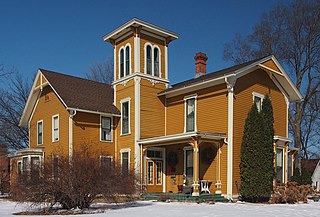
The Byron Howes House is a historic house located at 718 Vermillion Street in Hastings, Minnesota.

Hastings City Hall, formerly the Dakota County Courthouse, is a historic government building in Hastings, Minnesota, United States, completed in 1871. It was the original courthouse for Dakota County and now serves as city hall. It was designed by A.M. Radcliff, one of Minnesota's first architects, in an Italian Villa style. Although an addition built in 1955 in an entirely different style damaged the building's integrity, the building remains a prominent structure in downtown Hastings. The courthouse served as the seat of Dakota County government from 1871 until September 1974, when the county commissioners held their last meeting in the building. It became the Hastings City Hall in 1993.

The West Second Street Residential Historic District is a historic district in Hastings, Minnesota, United States. The district contains thirteen architecturally significant homes built between 1857 and 1890.
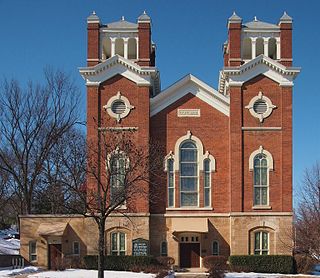
First Presbyterian Church, known also as First United Presbyterian Church, is a church located at 602 Vermillion Street in downtown Hastings, Minnesota, United States, listed on the National Register of Historic Places. It is significant for its Romanesque architecture. The building is characterized by its massive quality, its thick walls, round arches, large towers, and decorative arcading.

Hastings Methodist Episcopal Church is a church building located at 719 Vermillion Street in downtown Hastings, Minnesota, United States, listed on the National Register of Historic Places. It is significant for its Gothic Revival, Greek Revival, and Italianate architecture. The building exterior is clapboard with a characteristic tower including abat-sons and emphatic eaves supported by corbels. It is the oldest church building in Hastings, originally built in 1862 on 5th Street, it was moved to its present location in 1871; at that time the tower was added. The building is currently used by the Life Tabernacle Pentecostal Church.

The Thompson–Fasbender House, located at 649 West 4th Street in Hastings, Minnesota is listed on the National Register of Historic Places. It was built in 1880 by William Thompson who came to Minnesota in 1857 from Maine. He was a banker, wheat-buyer, and land-owner who also was part-owner of a saw mill and door and sash factory. His access to woodworkers is reflected in the home's finishing. Its Second Empire architecture is reflected in its mansard roof featuring scalloped wooden shingles and bracketed cornices.

The VanDyke–Libby House, located at 612 Vermillion Street in Hastings, Minnesota is listed on the National Register of Historic Places. It was built in 1868 by William J. Van Dyke, a banker and merchant. In 1880 the home was bought by Rowland C. Libby who was part-owner of a saw mill and door and sash factory. He lived there until 1911; in 1914 the building was converted to a sanitarium. Originally known as Hope Sanitarium, its name was later changed to St. Raphael's Hospital, which in 1929 moved to the Thompson-Fasbender House.
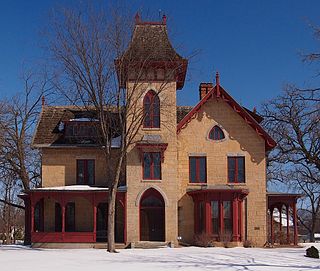
The William G. LeDuc House, also known as the LeDuc Historic Estate, located at 1629 Vermillion Street in Hastings, Minnesota, United States, is listed on the National Register of Historic Places. It was built over several years, and completed in 1865, by William Gates LeDuc who came to Minnesota in 1850 from Ohio. He was an attorney who represented a party to a suit involving Vermillion Falls, 1,500 feet (457 m) southeast of the homesite. As payment for his services, Le Duc received the land where he built his house. LeDuc was a Civil War veteran and U.S. Commissioner of Agriculture under President Hayes (1877–1881).

The Alexander Faribault House is a historic house museum in Faribault, Minnesota, United States. Built in 1853, it was the first wood-frame house constructed in Rice County, Minnesota. It was built by fur trader Alexander Faribault in the Greek Revival style. Besides serving as a house, it also served as a civic center, polling place, and a church. The local address of the house is 12 First Avenue, Faribault, MN. The house was listed on the National Register of Historic Places in 1970.
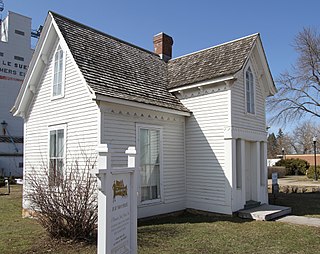
The Dr. William W. Mayo House, located at 118 North Main Street in Le Sueur, Minnesota, United States, is listed on the National Register of Historic Places (NRHP). It was built in 1859 by James Mayo and his brother, William Worrall Mayo who emigrated from Salford, United Kingdom, to the United States in 1846 and became a doctor. William's older son, William James Mayo was born in the home in 1861. William W. Mayo aided pioneers and their families during the Dakota War of 1862 and later moved to Rochester where he became the examining surgeon for the southern Minnesota Civil War draft board. He and his sons, William and Charles founded the 27-bed Saint Marys Hospital which opened in 1889 following the 1883 Rochester tornado. They later founded their namesake, the Mayo Clinic.
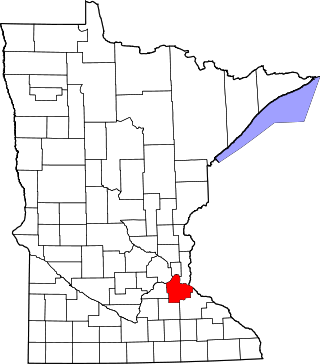
This is a list of the National Register of Historic Places listings in Dakota County, Minnesota. It is intended to be a complete list of the properties and districts on the National Register of Historic Places in Dakota County, Minnesota, United States. Dakota County is located in the southeastern part of the U.S. state of Minnesota, bounded on the northeast side by the Upper Mississippi River and on the northwest by the Minnesota River. The locations of National Register properties and districts for which the latitude and longitude coordinates are included below, may be seen in an online map.

The Hastings Foundry-Star Iron Works is a historic foundry building in Hastings, Minnesota, United States. Located at 707 First Street East, it was built by A. R. Morrell, an ironsmith from Vermont, in 1859. The building is historically significant as the location where the first steam engine in Minnesota was built (1860). In 1861 the engine for the Stella Whipple was manufactured there as well. Iron for bridges and engines for railroad elevators, automobiles, and river boats were manufactured in this earliest surviving industrial site in the state.

The Rudolph Latto House is a historic house in Hastings, Minnesota, United States, built 1880–1881. It is listed on the National Register of Historic Places for local significance in architecture for its transitional Italianate/Eastlake design. It was built in white Chaska brick.
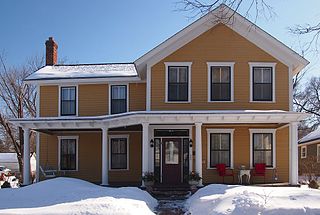
The MacDonald–Todd House is an 1857 home in Hastings in the U.S. state of Minnesota. The Greek Revival-style house was built by A.W. MacDonald in the utopian town of Nininger when he relocated to Dakota County from New York. He came to become the managing editor of the Emigrant Aid Journal. The paper was owned by Lieutenant Governor Ignatius Donnelly, who also founded the community of Nininger. In 1866, the home was moved across the ice in the Mississippi River to its present location, by Irving Todd, who had bought it for $385.

The Ignatius Eckert House is historic house in Hastings, Minnesota, United States. It was built in Nininger, Minnesota, in the early 1850s and moved to Hastings in 1857 by then-owner Thomas Reed. The house is listed on the National Register of Historic Places for its local significance in architecture as an exemplary specimen of an Italian Villa-style house with a cupola. It is an example of the "Country Homes" style of Andrew Jackson Downing, a pioneer in American landscape architecture. The original owner, Reverend G. W. T. Wright, was a minister at the nearby Hastings Methodist Episcopal Church. Ignatius Eckert, a retired farmer, bought the home around 1909.
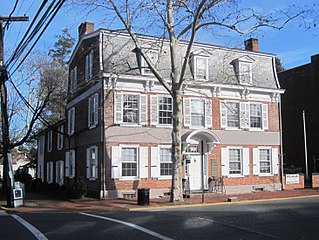
The Francis Hopkinson House is an historic house at 101 Farnsworth Street in Bordentown, Burlington County, New Jersey, United States. Built in 1750, it was the home of Founding Father Francis Hopkinson (1737-1791), the designer of the United States Flag and a signer of the United States Declaration of Independence. He lived in this home with his wife Ann Borden (1747-1827) from 1774 until Hopkinson's death in 1791. Ann Borden was the granddaughter of Joseph Borden, the founder of Bordentown, New Jersey. The house was designated a National Historic Landmark in 1971.

The James L. Lawther House is an octagon house in Red Wing, Minnesota, United States. The owner, James Lawther, built it after he visited Dubuque, Iowa and toured the Langworthy House there. At the time, the Langworthy House was the grandest house of its type on the upper Mississippi River. The Lawther House was built in 1857, with an addition in 1870. Its location, at the corner of Third and Hill Streets, has been termed "one of the most architecturally significant intersections in Minnesota" and is part of the Red Wing Residential Historic District. It is listed on the National Register of Historic Places.

The Sibley Historic Site is the site of Henry Hastings Sibley's home, who was the regional manager of the American Fur Company and Minnesota's first governor. It is one of the 26 historical sites that are operated by the Minnesota Historical Society. Located in what is now the city of Mendota, the site consists of four limestone buildings and a large lawn area. Three of the buildings are open for touring, including a fur company cold store from 1843 and the 1840 home of fur trader and hotelier Jean-Baptiste Faribault.

























